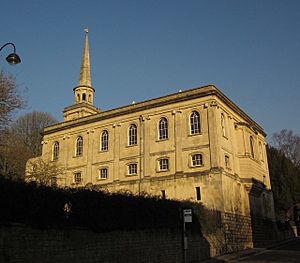Church of St Swithin, Bath facts for kids
Quick facts for kids Church of St Swithin |
|
|---|---|
 |
|
| Location | Bath, England |
| Built | 1779–1790 |
|
Listed Building – Grade II*
|
|
| Designated | 12 June 1950 |
| Reference no. | 1394245 |
| Lua error in Module:Location_map at line 420: attempt to index field 'wikibase' (a nil value). | |
The Church of St Swithin is a beautiful old church in Bath, England. It's located on a street called The Paragon, in the Walcot area. This church was built a long time ago, between 1777 and 1790. It's considered a very important historical building, known as a Grade II* listed building. This means it's protected because of its special history and architecture.
Contents
A Look at St Swithin's Church History
The Church of St Swithin stands on a very old site. There was another church here even before the current one.
The Old Church and Its Name
The original church on this spot dated back to the 10th century. Its remains are still hidden beneath the current church's crypt. The church is named after Swithun. He was an Anglo-Saxon bishop from Winchester. He later became the patron saint of Winchester Cathedral.
Famous People Connected to the Church
Many famous people have connections to St Swithin's Church.
Jane Austen's Family
The parents of the famous writer Jane Austen were married here. George Austen and Cassandra Leigh got married at St Swithin's on April 26, 1764. Jane Austen's father, George Austen, is also buried at the church.
Building the Current Church
The church you see today was built by an architect named John Palmer. He worked on it between 1777 and 1790. His new church opened in 1777. However, Bath was growing very fast, and the church soon became too small. More and more people were moving to the city.
Other Notable Connections
On May 30, 1797, William Wilberforce was married in the church. He was a very important person who worked to end slavery. He married Barbara Spooner Wilberforce here.
The church is also the burial place for other well-known figures. The writer and poet Christopher Anstey was buried here in 1805. Rear Admiral Sir Edward Berry was buried in 1831. The famous writer Frances Burney was buried here in 1840. Her husband, General Alexandre D'Arblay, was buried in the church in 1818.
Church Features and Additions
The church house, which is number 38 The Paragon, was built in the early 1700s. In the 1840s, a beautiful stained glass window was added to the east wall. This window shows a picture of the Ascension of Jesus. The cemetery next to the church has special gates. These gates have a unique design with a rough stone base. They also feature panels with upside-down torches between pillars.

